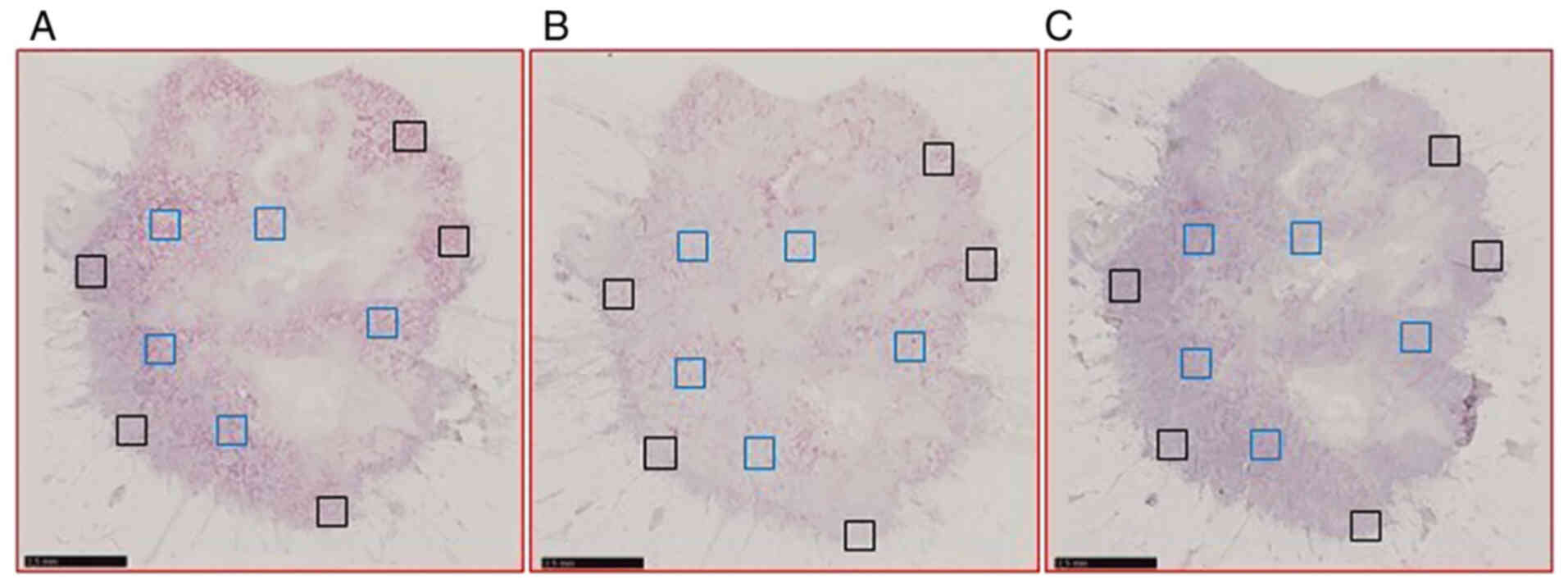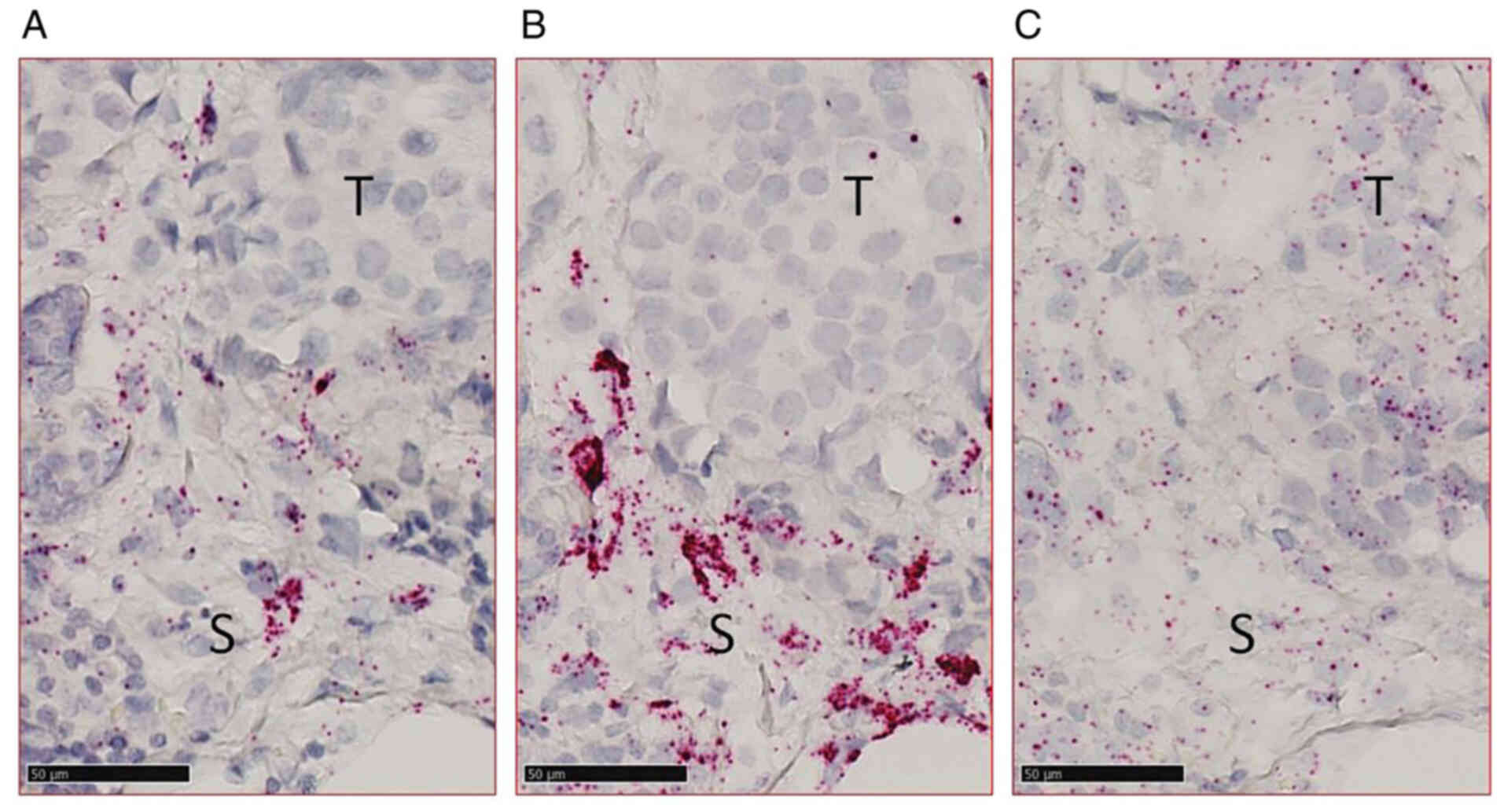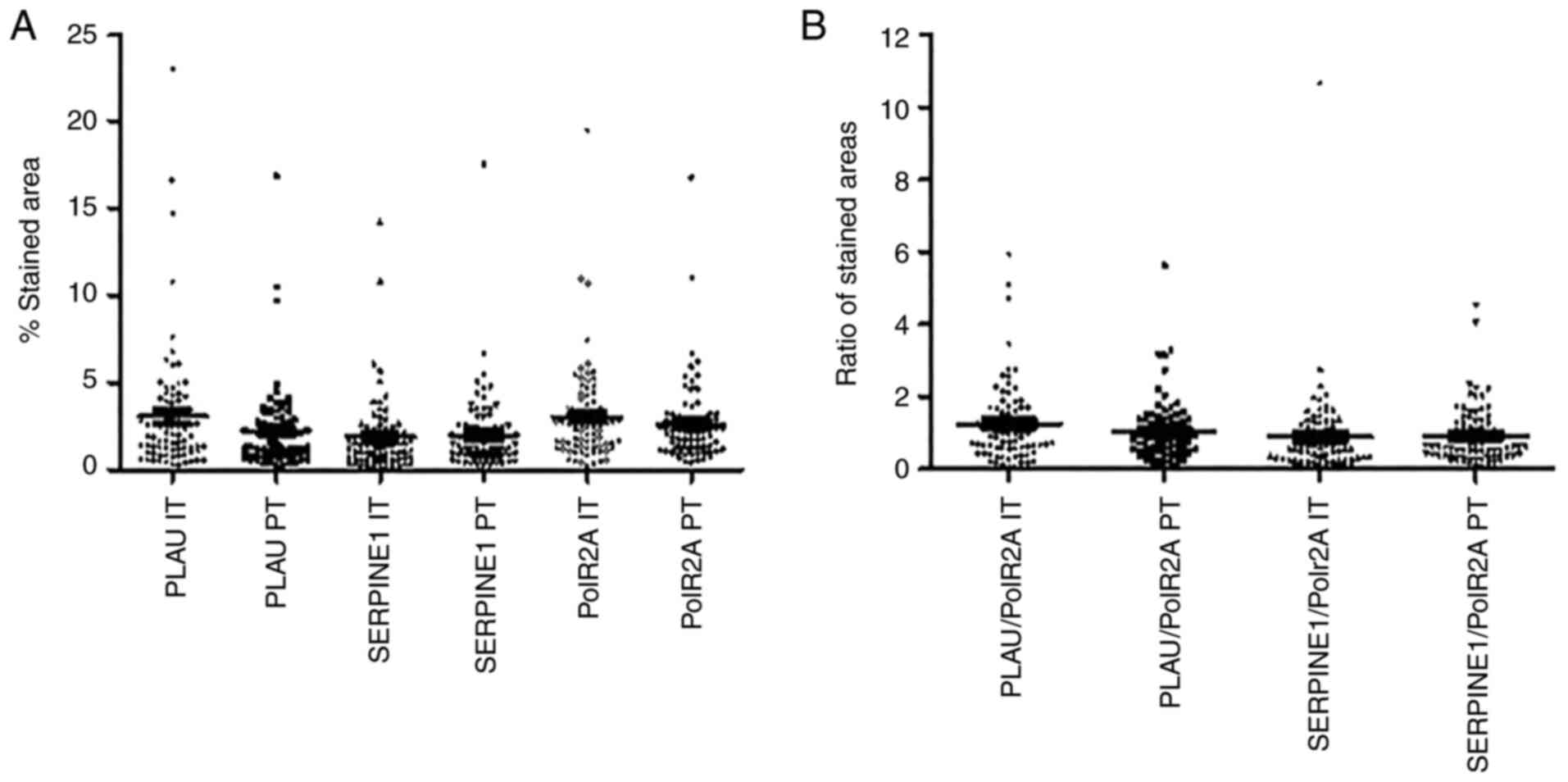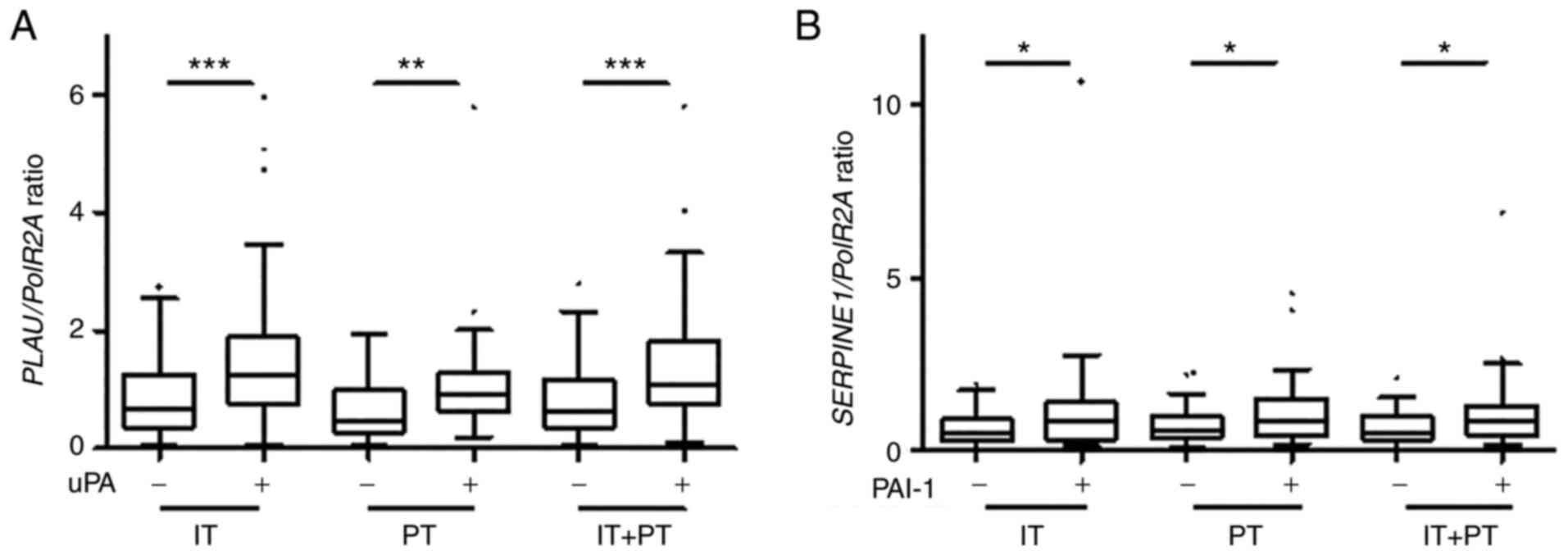|
1
|
Mahmood N, Mihalcioiu C and Rabbani SA:
Multifaceted role of the urokinase-type plasminogen activator (uPA)
and its receptor (uPAR): Diagnostic, prognostic, and therapeutic
applications. Front Oncol. 8:242018. View Article : Google Scholar : PubMed/NCBI
|
|
2
|
Ettl J, Klein E, Hapfelmeier A, Grosse
Lackmann K, Paepke S, Petry C, Specht K, Wolff L, Höfler H and
Kiechle M: Decision impact and feasibility of different
ASCO-recommended biomarkers in early breast cancer: Prospective
comparison of molecular marker EndoPredict and protein marker
uPA/PAI-1. PLoS One. 12:e01839172017. View Article : Google Scholar : PubMed/NCBI
|
|
3
|
Duffy MJ, McGowan PM, Harbeck N, Thomssen
C and Schmitt M: uPA and PAI-1 as biomarkers in breast cancer:
Validated for clinical use in level-of-evidence-1 studies. Breast
Cancer Res BCR. 16:4282014. View Article : Google Scholar : PubMed/NCBI
|
|
4
|
Luporsi É, André F, Bellocq J-P, Caron Y,
Fumoleau P, Gompel A, Martin P-M, Roché H, Salmon R, Sigal-Zafrani
B, et al: Rapport 2009 sur l'état des connaissances relatives aux
biomarqueurs tissulaires uPA/PAI-1, Oncotype DXTM et
MammaPrint® dans la prise en charge du cancer du sein.
Oncologie. 12:158–163. 2010. View Article : Google Scholar
|
|
5
|
Paik S, Shak S, Tang G, Kim C, Baker J,
Cronin M, Baehner FL, Walker MG, Watson D, Park T, et al: A
multigene assay to predict recurrence of tamoxifen-treated,
node-negative breast cancer. N Engl J Med. 351:2817–2826. 2004.
View Article : Google Scholar : PubMed/NCBI
|
|
6
|
Filipits M, Rudas M, Jakesz R, Dubsky P,
Fitzal F, Singer CF, Dietze O, Greil R, Jelen A, Sevelda P, et al:
A new molecular predictor of distant recurrence in ER-positive,
HER2-negative breast cancer adds independent information to
conventional clinical risk factors. Clin Cancer Res. 17:6012–6020.
2011. View Article : Google Scholar : PubMed/NCBI
|
|
7
|
Parker JS, Mullins M, Cheang MC, Leung S,
Voduc D, Vickery T, Davies S, Fauron C, He X, Hu Z, et al:
Supervised risk predictor of breast cancer based on intrinsic
subtypes. J Clin Oncol. 27:1160–1167. 2009. View Article : Google Scholar : PubMed/NCBI
|
|
8
|
Ahn SK and Jung SY: Current biomarkers for
precision medicine in breast cancer. Adv Exp Med Biol.
1187:363–379. 2021. View Article : Google Scholar : PubMed/NCBI
|
|
9
|
Vénat-Bouvet L, Fermeaux V, Leobon S,
Saidi N, Monteil J, Mollard J, Aubard Y, Jammet I and
Tubiana-Mathieu N: Adjuvant chemotherapy in node-negative breast
cancer: UPA/PAI-1 determinations for 163 cases. Anticancer Res.
34:1213–1217. 2014.PubMed/NCBI
|
|
10
|
Costantini V, Sidoni A, Deveglia R,
Cazzato OA, Bellezza G, Ferri I, Bucciarelli E and Nenci GG:
Combined overexpression of urokinase, urokinase receptor, and
plasminogen activator inhibitor-1 is associated with breast cancer
progression: An immunohistochemical comparison of normal, benign,
and malignant breast tissues. Cancer. 77:1079–1088. 1996.
View Article : Google Scholar : PubMed/NCBI
|
|
11
|
Göhring UJ, Scharl A, Thelen U, Ahr A and
Crombach G: Comparative prognostic value of Cathepsin D and
urokinase plasminogen activator, detected by immunohistochemistry,
in primary breast carcinoma. Anticancer Res. 16:1011–1018.
1996.PubMed/NCBI
|
|
12
|
Lang DS, Heilenkötter U, Schumm W, Behrens
O, Simon R, Vollmer E and Goldmann T: Optimized
immunohistochemistry in combination with image analysis: A reliable
alternative to quantitative ELISA determination of uPA and PAI-1
for routine risk group discrimination in breast cancer. Breast.
22:736–743. 2013. View Article : Google Scholar : PubMed/NCBI
|
|
13
|
Singer CF, Filipits M, Jahn SW, Abete L,
Jakesz R, Greil R, Bauernhofer T, Kwasny W, Seifert M, Fitzal F, et
al: Stromal coexpression of uPA/PAI-1 protein predicts poor disease
outcome in endocrine-treated postmenopausal patients with
receptor-positive early breast cancer. Breast. 46:101–107. 2019.
View Article : Google Scholar : PubMed/NCBI
|
|
14
|
Han B, Nakamura M, Mori I, Nakamura Y and
Kakudo K: Urokinase-type plasminogen activator system and breast
cancer (Review). Oncol Rep. 14:105–112. 2005.PubMed/NCBI
|
|
15
|
Lamy PJ, Verjat T, Servanton AC, Paye M,
Leissner P and Mougin B: Urokinase-type plasminogen activator and
plasminogen activator inhibitor type-1 mRNA assessment in breast
cancer by means of NASBA: correlation with protein expression. Am J
Clin Pathol. 128:404–413. 2007. View Article : Google Scholar : PubMed/NCBI
|
|
16
|
Spyratos F, Bouchet C, Tozlu S, Labroquere
M, Vignaud S, Becette V, Lidereau R and Bieche I: Prognostic value
of uPA, PAI-1 and PAI-2 mRNA expression in primary breast cancer.
Anticancer Res. 22:2997–3003. 2002.PubMed/NCBI
|
|
17
|
Castelló R, Estellés A, Vázquez C, Falcó
C, España F, Almenar SM, Fuster C and Aznar J: Quantitative
real-time reverse transcription-PCR assay for urokinase plasminogen
activator, plasminogen activator inhibitor type 1, and tissue
metalloproteinase inhibitor type 1 gene expressions in primary
breast cancer. Clin Chem. 48:1288–1295. 2002. View Article : Google Scholar : PubMed/NCBI
|
|
18
|
Castelló R, Landete JM, España F, Vázquez
C, Fuster C, Almenar SM, Ramón LA, Radtke KP and Estellés A:
Expression of plasminogen activator inhibitors type 1 and type 3
and urokinase plasminogen activator protein and mRNA in breast
cancer. Thromb Res. 120:753–762. 2007. View Article : Google Scholar : PubMed/NCBI
|
|
19
|
Evers DL, Fowler CB, Cunningham BR, Mason
JT and O'Leary TJ: The effect of formaldehyde fixation on RNA. J
Mol Diagn. 13:282–288. 2011. View Article : Google Scholar : PubMed/NCBI
|
|
20
|
Wang F, Flanagan J, Su N, Wang LC, Bui S,
Nielson A, Wu X, Vo HT, Ma XJ and Luo Y: RNAscope: A novel in
situ RNA analysis platform for formalin-fixed,
paraffin-embedded tissues. J Mol Diagn. 14:22–29. 2012. View Article : Google Scholar : PubMed/NCBI
|
|
21
|
Viala M, Alexandre M, Thezenas S, Lamy PJ,
Maran-Gonzalez A, Gutowski M, Colombo PE, Romieu G, Jacot W and
Guiu S: Prognostic impact of the inclusion of uPA/PAI-1 for
adjuvant treatment decision-making in ER+/Her2- pN0 early breast
cancers. Breast Cancer Res Treat. 165:611–621. 2017. View Article : Google Scholar : PubMed/NCBI
|
|
22
|
Harbeck N, Thomssen C, Berger U, Ulm K,
Kates RE, Höfler H, Jänicke F, Graeff H and Schmitt M: Invasion
marker PAI-1 remains a strong prognostic factor after long-term
follow-up both for primary breast cancer and following first
relapse. Breast Cancer Res Treat. 54:147–157. 1999. View Article : Google Scholar : PubMed/NCBI
|
|
23
|
Jänicke F, Prechtl A, Thomssen C, Harbeck
N, Meisner C, Untch M, Sweep CG, Selbmann HK, Graeff H and Schmitt
M; German N0 Study Group, : Randomized adjuvant chemotherapy trial
in high-risk, lymph node-negative breast cancer patients identified
by urokinase-type plasminogen activator and plasminogen activator
inhibitor type 1. J Natl Cancer Inst. 93:913–920. 2001. View Article : Google Scholar : PubMed/NCBI
|
|
24
|
Schneider CA, Rasband WS and Eliceiri KW:
NIH image to ImageJ: 25 years of image analysis. Nat Methods.
9:671–675. 2012. View Article : Google Scholar : PubMed/NCBI
|
|
25
|
Landini G, Martinelli G and Piccinini F:
Colour deconvolution: Stain unmixing in histological imaging.
Bioinformatics. 37:1485–1487. 2021. View Article : Google Scholar : PubMed/NCBI
|
|
26
|
Radonić A, Thulke S, Mackay IM, Landt O,
Siegert W and Nitsche A: Guideline to reference gene selection for
quantitative real-time PCR. Biochem Biophys Res Commun.
313:856–862. 2004. View Article : Google Scholar : PubMed/NCBI
|
|
27
|
Saviozzi S, Cordero F, Lo Iacono M,
Novello S, Scagliotti GV and Calogero RA: Selection of suitable
reference genes for accurate normalization of gene expression
profile studies in non-small cell lung cancer. BMC Cancer.
6:2002006. View Article : Google Scholar : PubMed/NCBI
|
|
28
|
Biermann JC, Holzscheiter L, Kotzsch M,
Luther T, Kiechle-Bahat M, Sweep FC, Span PN, Schmitt M and
Magdolen V: Quantitative RT-PCR assays for the determination of
urokinase-type plasminogen activator and plasminogen activator
inhibitor type 1 mRNA in primary tumor tissue of breast cancer
patients: Comparison to antigen quantification by ELISA. Int J Mol
Med. 21:251–259. 2008.PubMed/NCBI
|
|
29
|
Witzel I, Milde-Langosch K, Schmidt M,
Karn T, Becker S, Wirtz R, Rody A, Laakmann E, Schütze D, Jänicke F
and Müller V: Role of urokinase plasminogen activator and
plasminogen activator inhibitor mRNA expression as prognostic
factors in molecular subtypes of breast cancer. OncoTargets Ther.
7:2205–2213. 2014. View Article : Google Scholar : PubMed/NCBI
|
|
30
|
Duncan DJ, Scott M, Scorer P and Barker C:
Assessment of PD-L1 mRNA and protein expression in non-small cell
lung cancer, head and neck squamous cell carcinoma and urothelial
carcinoma tissue specimens using RNAScope and immunohistochemistry.
PLoS One. 14:e02153932019. View Article : Google Scholar : PubMed/NCBI
|
|
31
|
Henley-Smith R, Santambrogio A, Andoniadou
CL, Odell E and Thavaraj S: RNA in situ hybridization for
human papillomavirus testing in oropharyngeal squamous cell
carcinoma on a routine clinical diagnostic platform. J Oral Pathol
Med. 50:68–75. 2021. View Article : Google Scholar : PubMed/NCBI
|
|
32
|
Tang W, Zhou M, Dorsey TH, Prieto DA, Wang
XW, Ruppin E, Veenstra TD and Ambs S: Integrated
proteotranscriptomics of breast cancer reveals globally increased
protein-mRNA concordance associated with subtypes and survival.
Genome Med. 10:942018. View Article : Google Scholar : PubMed/NCBI
|
|
33
|
Elston CW and Ellis IO: Pathological
prognostic factors in breast cancer. I. The value of histological
grade in breast cancer: Experience from a large study with
long-term follow-up. Histopathology. 19:403–410. 1991. View Article : Google Scholar : PubMed/NCBI
|


















